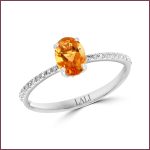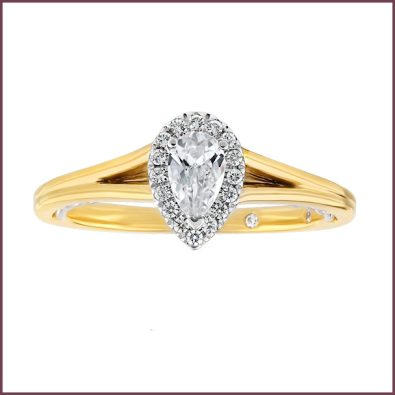Courting Jewelry Self Purchasers
According to The Plumb Club’s 2021 Industry & Market Insights, consumers feel traditional/classic style of jewelry best expresses them.
Self-purchase is the top motivator for consumers to buy fine jewelry, reports The Plumb Club Industry & Market Insights 2021. Forty percent of the 1,000 U.S. jewelry consumers surveyed for the report rate self-purchase most important.
Recent jewelry market research by several industry organizations underscores the importance of the self-purchaser for jewelry sales moving forward. The JCK 2021 State of the Jewelry Industry Report, released this summer, hails the self-purchaser to be the “new buyer” the trade should focus on.
Women are expected to be the largest segment of customers in the future, finds Fortune Business Insights. It is estimated that by 2028 women will own 75% of the discretionary spend, making them the world’s greatest influencers. In fact, currently in the U.S. women drive 80%-85% of consumer purchasing through a combination of buying power and influence.
According to Lyst, women account for 78% of women’s jewelry purchases on the popular fashion platform. Just over half of Millennial women buy their own jewelry cites a Capital Counselors study. Not surprising, De Beers and the Women’s Jewelry Association launched campaigns targeting self-purchasing women.
Net-A-Porter, the online fashion platform, says that the most popular brands on its sight for self-gifting are jewelry designers, particularly women designing for women. Women now add fine jewelry and watches to their digital baskets alongside handbags, shoes and fashion, the platform reports. It also notes that while traditionally, male customers are concerned with investment potential and ‘getting their money’s worth’, when it comes to self-gifting, women are more focused on how a piece looks and feels, and the emotional connection it evokes.
While women are the biggest consumer group self purchasing, men also are buying fine jewelry for themselves today. In a July 2021 survey conducted by THE MVEye for the Cultured Pearl Association of America (CPAA) of over 1,000 U.S. jewelry consumers, more than a third (35%) are self-described self-purchasers. What’s exciting in this new data is that not only women (35%), but also men (36%) self-identify as self-purchasers of all types of fine jewelry. In fact, the report shows that all age groups, from 25-55, embrace the idea of buying fine jewelry for themselves, with the most enthusiastic group ages 25-35.
Reasons to Self-Gift
While nearly half of consumers surveyed by TPC say they buy jewelry for special occasions, nearly a quarter say they need no reason at all.
Theresa Namie, merchandise manager for Ostbye, in Minneapolis, Minnesota, notes that female self-purchasers are different today than they were even one year ago. “So much has changed and so have we,” she says. “We are now really looking at overall wellbeing and self-care. In the jewelry world this can be interpreted as if I look good, I will feel better. The trend as gone from impulse buying into really thinking about what would look good and make me feel better.”
Men, too, have been investing in their appearance, from grooming products to fine jewelry — a Millennial influenced trend that continues with Gen Z. Men’s jewelry has become an increasingly important category, with self-purchasing men fueling the growth, reports Valerie Fletcher, vice president of design and product development for Original Design Inc. (ODI) in New York.
TPC Insights finds that tried-and-tested gender, age, and income-based consumer groups and marketing concepts do not cut it. A new mix of eras is blending in innovative ways, with the rise of Millennials and Gen Z, and with Gen X and Boomers living longer and behaving much younger than anticipated. A segmentation based on mindsets and persuasions makes more sense, clustering people according to similarities in activities, thought processes, convictions, and values makes more sense.
Many companies often identify market segments using demographics alone. Few would agree that consumers are neatly defined by age, gender, or income. As consumer dynamics shift, brands need to place as much value on psychographics — the study and classification of people according to their attitudes, aspirations and other psychological criteria, finds TPC Insights.
Classic Trending
Consumers feel that traditional/classic style of jewelry best expresses them. The Plumb Club Industry & Market Insights 2021 found 44% of 1,000 U.S. jewelry consumers feel that way
“Fast fashion options are fewer with the economic impact over the last 18 months, but what we are seeing is a trend to a considered purchase that can last through any turn in our daily lives,” says Kaitlin Derkach, spokesperson for the watch brands Citizen and Bulova. “We’re taking stock in what we have at home, in our closet or jewelry box. Timeless trumps fashion, classics that can be worn with lifestyle and longer-term options. It’s somewhat the same for men, with a casual slant.”
Everyday jewelry is hands down the biggest trend for self-purchasers, reports Fran Penella, spokesperson for Mastoloni Pearls, New York. “We are seeing how important it is that a piece of jewelry be versatile enough to wear morning, noon and night, and for any occasion.”
Classic styles rock for men, as well. With the re-opening of public venues, Malia Villanueva for the Breuning in Lawrenceville, Georgia has seen a lot of cufflink sales for men returning to work and events. “We’ve also seen sales rise for customizable signet rings for self-purchasing men.” Breuning’s latest men’s collection, Marcus, is crafted in gold and silver with gems like lapis and onyx.
Motivating the Sale
Nearly a third and a quarter of consumers rate design and quality, respectively, as the leading considerations when buying jewelry, with only 16% citing price. However, TPC Insights finds that 57% of consumers say that the availability of financing is an important purchaser motivator.
TPC Insights finds the average spend to be about $1,200, with the ability to finance a big draw to close the sale.
With financing being one of the biggest problems hindering retailers, having the ability to offer a customer credit card equals more opportunities to close sales, higher average open to buy, and will keep customers coming back year after year, underscores Alok Mehta, president and CEO of IDD, New York.
Launched in 2014, the diamond jewelry manufacturer’s IDDeal Credit Card Program offers benefits including broad credit approvals, generous limits, multiple payment plans, promotional and holiday rates, a fast and easy application process, and no recourse for retailers, fees or equipment to buy.
“The idea behind the IDDeal card was to offer a credit program for independents and small chains to help close more high-ticket sales by offering a credit option that allows customers to keep those purchases separate from their general-purpose credit cards,” explains Mehta. “Most independent retailers can’t compete with the larger banners on credit, resulting in a significant loss of sales.”
Digital technology is so important, underscores Namie. “We support our clients using marketing materials including art for ad work, Instagram and Facebook posts that build clean stories around love kindness and self-worth. We also have a new Holiday Wishbook in print and digital.”
According to TPC Insights, 85% of consumers surveyed say they are active on social media, with Facebook (93%) and Instagram (73%) most popular. Moreover, 59% have already made a purchase through social media.














